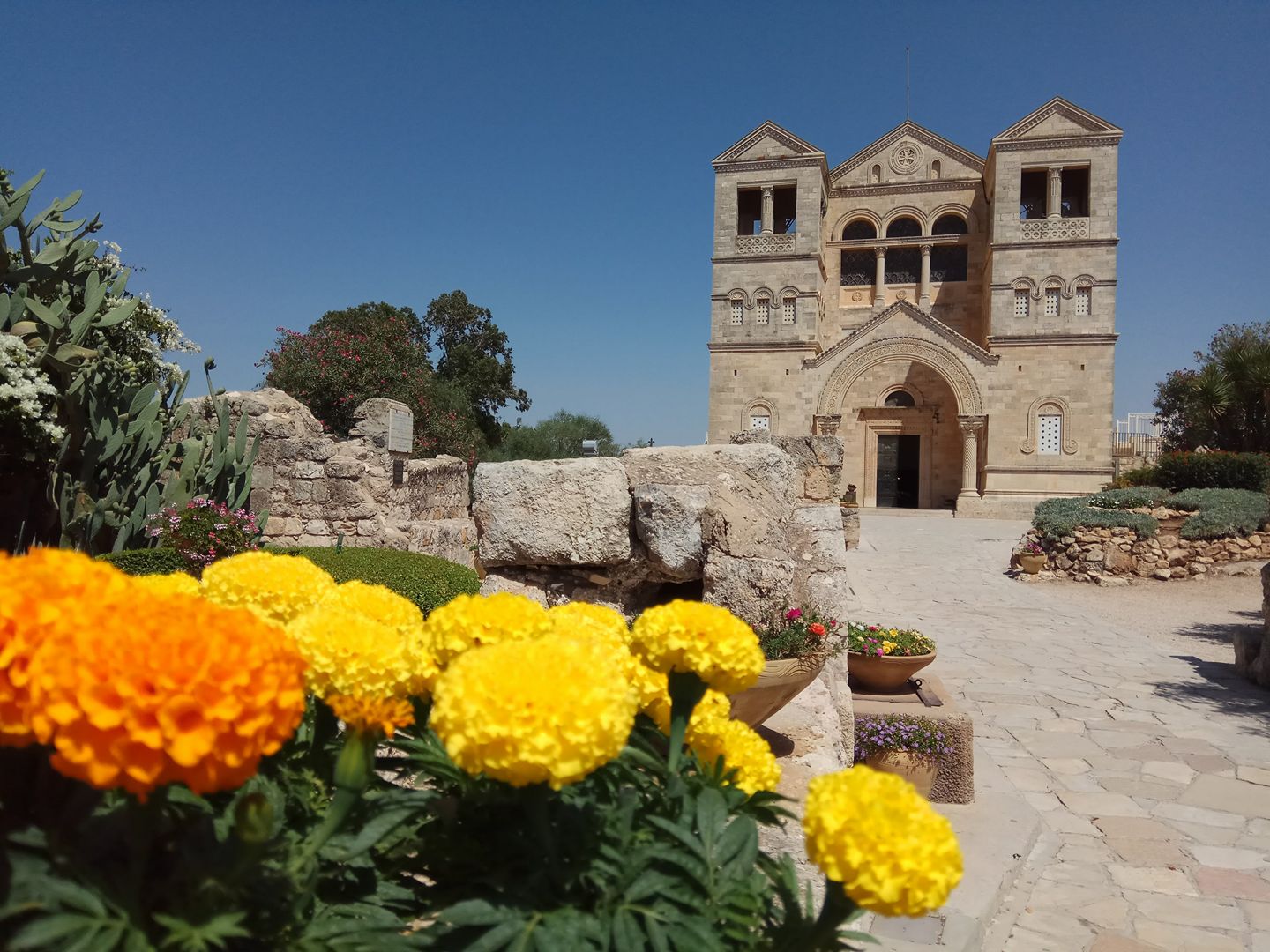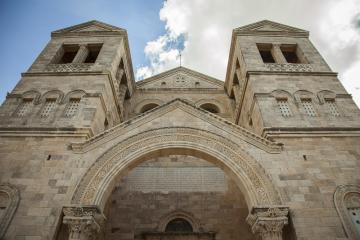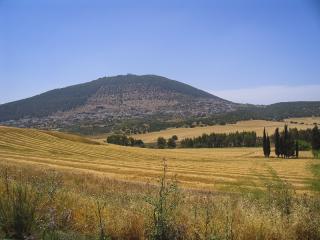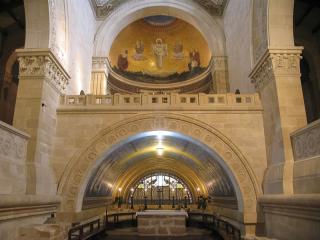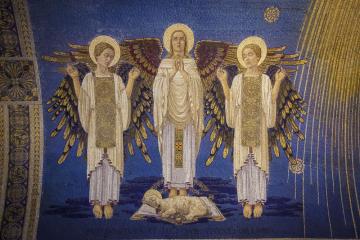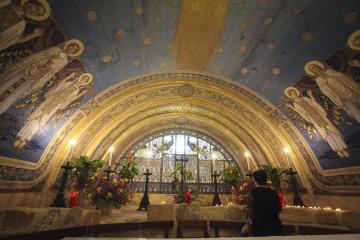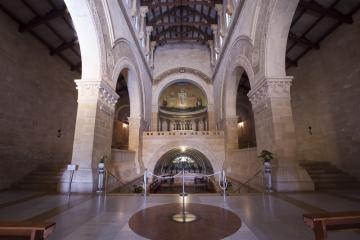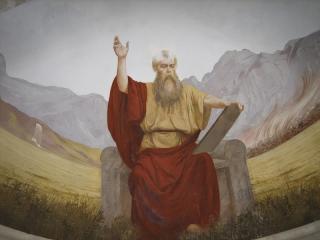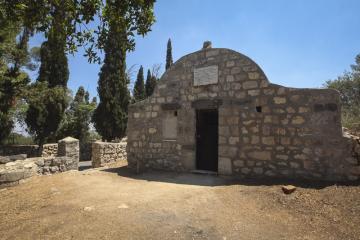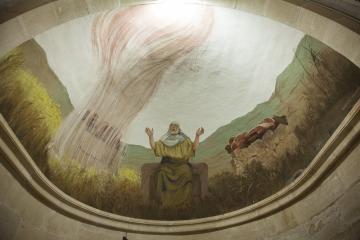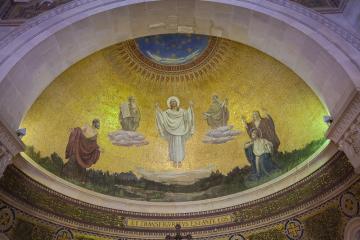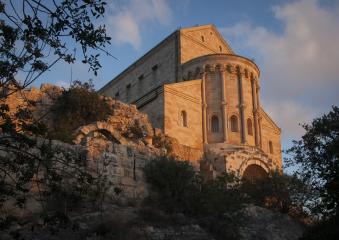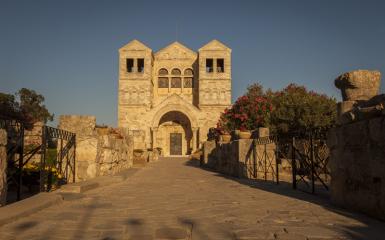At the top of Mount Tabor one finds oneself at a crossroads. On the left, one can go to the Greek sanctuary. On the right, crossing the wind gate, one enters the property of the Franciscans, first encountering, on the left hand side, a small cemetery, and the nearby chapel of the Descendentibus. It is a simple building without glass windows built in Byzantine style and rebuilt in 1923. The name alludes to the descent of the apostles from Mount Tabor:
As they were coming down [descendentibus, in the Latin Vulgate] from the mountain, he charged them not to relate what they had seen to anyone, except when the Son of Man had risen from the dead. So they kept the matter to themselves, questioning what rising from the dead meant. Then they asked him, “Why do the scribes say that Elijah must come first?” He told them, “Elijah will indeed come first and restore all things, yet how is it written regarding the Son of Man that he must suffer greatly and be treated with contempt? But I tell you that Elijah has come and they did to him whatever they pleased, as it is written of him” (Mark 9:-9-13).
Archaeological excavations have been undertaken since the nineteenth century. In 1921-24, the Franciscans built the current basilica, in the Syro-Roman style: the first work of the architect Antonio Barluzzi, who would then work for another decade to help the friars. The area of the basilica includes the land that has been venerated since the Byzantine era. The two bell towers rise over the ancient oratories of Moses and Elias, and the two respective chapels remain dedicated to these two great biblical characters who appeared next to Jesus during the Transfiguration. The interior of the church is divided into three naves. From the side aisles, the steps lead to the raised high altar, which the mosaic of Christ’s Transfiguration overlooks. Another staircase, which is as wide as the central nave, descends into the open crypt, in which the ancient apse has been preserved. The mosaics in the crypt deepen the meaning of trans-figuration: Jesus took on various figures gradually through his birth on earth, the institution of the Eucharist, his sacrifice on the cross and his resurrection.
To the north, on the left hand side, lie the ruins of the medieval Benedictine monastery. One notices a chapel and, farther back, the Chapter hall and the refectory. The watchtower to the south, on the right hand side, of the church is the work of the Saracens, while the remains of the defense walls, farther down, date back to Roman times.
The view from the terraces
The terraces located on the sides of the basilica offer magnificent panoramic views. To the east, beyond the banks of the Jordan and Lake Gennesaret, one can see the Golan and Basan heights, as well as the Jordanian highlands of Gilead crossed by the Yarmouk Valley. To the south, the view extends over the mountains of Samaria and Mount Gelboe, which sticks out toward the north, and also over the smaller Mount Hermon, from whose northern slopes Nain can be seen. In the distance to the west, the elongated silhouette of Mount Carmel can be seen; in the foreground, the mountainous area of Lower Galilee with Nazareth, whose modern district of Nazaret Illit is mainly visible. To the north, there are the mountains of Upper Galilee with the city of Zefat and, on a clear day, one can even see the real Mount Hermon, which remains snow-covered until the beginning of summer.
In the open space in front of the sanctuary stands the Franciscan monastery, which was built in 1873-75, with attached Casa Nova, which is a hostel for pilgrims. Since 2006, the Mondo X community has provided a valuable service for pilgrims and maintenance of the vast complex. It is an Italian association made up of people with past drug dependencies, which was established in 1961, and which today includes around 40 communities located mainly on the [Italian] Peninsula. After undergoing therapy that aims to free them from from the constraints of physical dependency, Mondo X members work to build a drug-free life for themselves through a rigid daily schedule, which includes manual work and spiritual life.
The northern part of the mountain is taken up by the properties belonging to the Greek Orthodox community, which can only be accessed by pilgrims via the Orthodox Church. The church of St. Elias was built in 1911 on the foundations of a Crusader-era temple, but in any case it stands on originally Byzantine foundations, as shown by the mosaic floor. Toward the west, taking the path to the left of the wind gate, there is a grotto where medieval pilgrims honored the home of the famous Melchizedek, who blessed Abraham and in turn received tithes (Gen 14: 18-20). The grotto was restored in 2009, but is usually closed.
